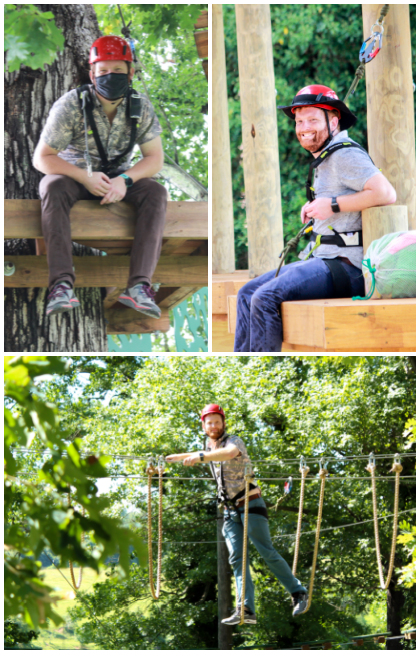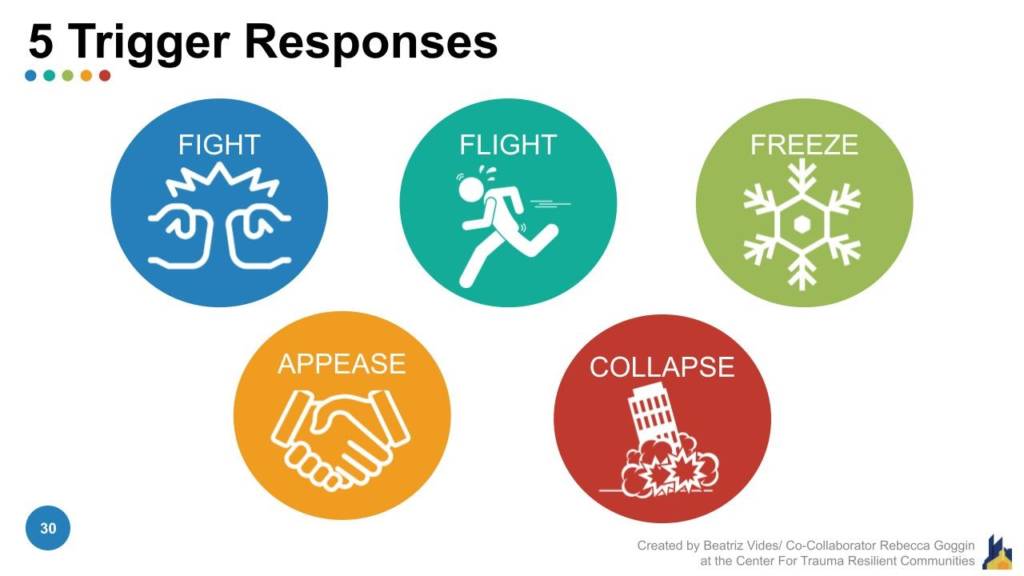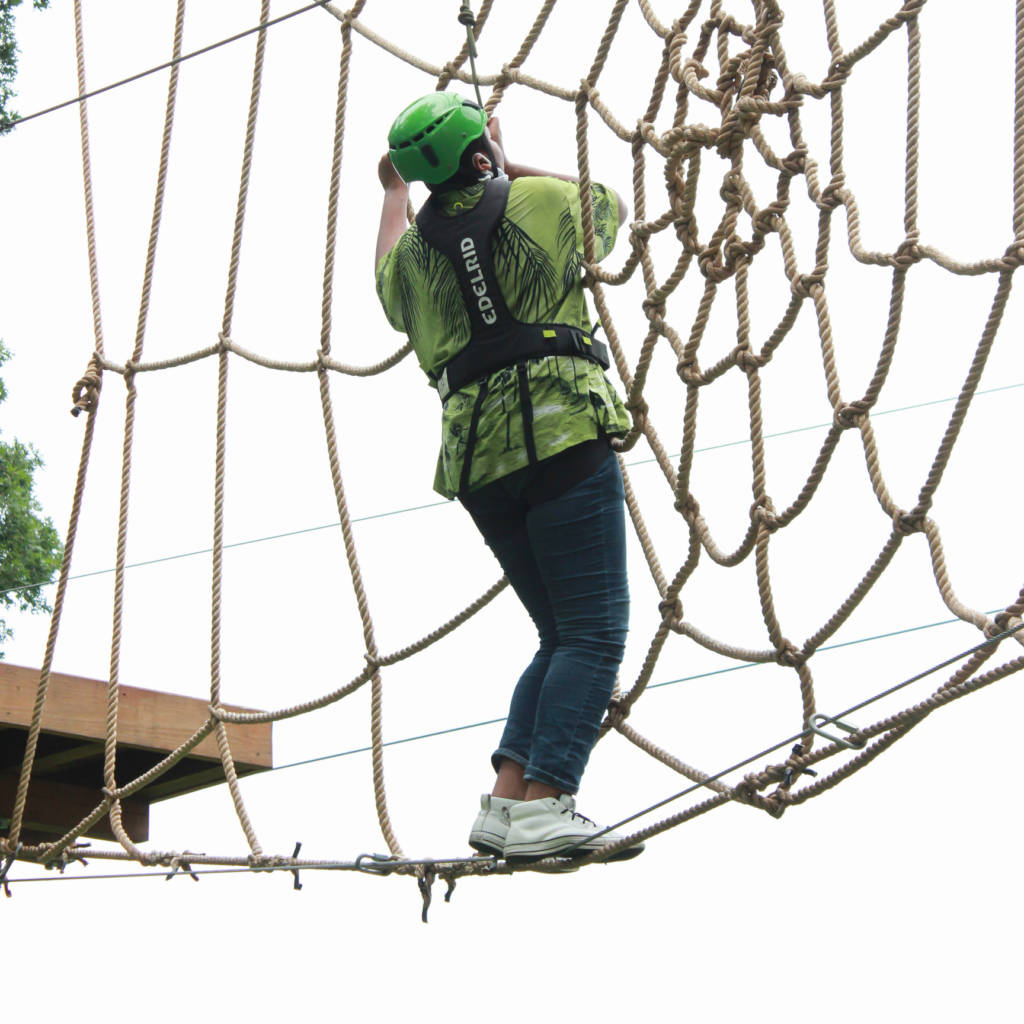I spend a significant amount of my working hours on our aerial adventure park or our Aerial Teams Course (ATC). On the course, we explore and guide people through personal and group experiential programs. As you can see, my team spends a lot of time way up in the air! Here, we challenge ourselves and collaborate to solve problems.

I also spend a lot of time training groups and teams on trauma resilience concepts. I get to work with clients within the agency and also through the Center for Trauma Resilient Communities. While it can be a bit difficult to describe exactly what I do for work, these two components of my work provide a nice variety of change within my day-to-day schedule. I find that the knowledge and concepts from our trauma resilience training come up in every ropes course session. This knowledge has transformed how I facilitate – and my facilitation experience has completely changed how I train the brain!
5 Trigger Responses
One of the core concepts in our Trauma 101 training is the universal stress response of our brain and body. These responses include fight, flight, freeze, appease, or crash. Positive stress is really critical to our individual well-being (think exercise, preparing for tests or presentations, etc.). But we are considering the type of stress that kicks our limbic system up into the driver seat. We each have our default learned stress responses. Whether we are aware of these default responses or not, our brains and bodies have learned these responses keep us safe in important moments. Since our brains like routine, without personal work and self-awareness, these responses will be the go-to.

Maybe you’re unsure about your go-to stress response? Imagine for a moment you are outside walking on a trail. It is a crisp fall morning. You are enjoying the solitude and are staying well-hydrated and well-fed because you DESERVE IT! This is the year of YOU! You are snapping the most Instagram-worthy photo of a super colorful, freshly-fallen maple leaf, capturing every intricate detail, and oh wow is that a caterpill- . . . when all of a sudden you notice a BEAR IN THE BACKGROUND OF THE PHOTO! AHHH!

How will your survival brain respond?
*pause*
In this scenario, did you just:
- Raise your fists up, ready to give that bear the best jab, jab, uppercut combo? Because you did watch Rocky, after all. (Hint: you’re might be a fighter.)
- Pivot your feet, inspired by the athleticism and speed of Allyson Felix and jolt back down the trail to your car? (Hint: you may default to flight.)
- Feel some combination of 1) your legs being immediately set in concrete and 2) the passage of time just became impossibly slow? (Hint: freezing might be your go-to.)
- Consider how the bear might be feeling in this moment. Smokey the Bear was always so admirable, and maybe this bear just needs a you-sized meal? (Hint: you may have learned that appeasing is a functional way of mitigating your stress)
- Quite legitimately stop functioning all together? (Hint: this is collapse, which is worth its own entire blog post.)
Our pre-frontal cortex is responsible for abstract thought, problem solving, and other important functions. There are myriad techniques to bring our pre-frontal cortex back online after we’ve just encountered the bear, or after our brain perceives a threat and does what it knows best in order to keep our body safe.
Can you see how far we are from the ground?
On the ropes course, I see these behaviors in virtually every session. Typically, when you are suspended 15-50 feet in the air by a harness and cables, your brain does everything to tell your body, “HEY! CUT IT OUT! THIS IS DANGEROUS, CAN YOU SEE HOW FAR AWAY WE ARE FROM THE GROUND??” Externally, we see this is in avoidant eye contact, or really stiff movements. Sometimes guests do their best Elvis impression, wobbling their hips side to side on a bridge or cable. The beauty in this moment is that my team and I get to let the guest experiencing that stress response know that their brain is doing EXACTLY what it is supposed to!
Often, when I notice a guest who is going through that fight-flight-freeze-appease-collapse response, I will ask them “what are you feeling right now?” or, “what are you noticing at this moment?” Frequently, when our limbic system takes over as the driver, it can be difficult to self-regulate. We can even live in circumstances of such high stress that the limbic system never stops driving.
Your survival brain is scared!
 I will never forget one time I asked that feeling question to a young girl. She immediately responded with a scream, “SCARED!” First, I praised the emotional intelligence in that moment. It meant she could identify the feeling, which is important when some folks cannot escape that constant state of stress response. Next, I asked how she knew physically that she was scared. She told me her legs felt like cooked spaghetti noodles that did not want to hold up her body. What precise language of an emotional response!
I will never forget one time I asked that feeling question to a young girl. She immediately responded with a scream, “SCARED!” First, I praised the emotional intelligence in that moment. It meant she could identify the feeling, which is important when some folks cannot escape that constant state of stress response. Next, I asked how she knew physically that she was scared. She told me her legs felt like cooked spaghetti noodles that did not want to hold up her body. What precise language of an emotional response!
Without missing a beat she then started saying aloud, “dolphins eating peanut butter and jelly sandwiches!” and kept moving across the bridge that she had stopped on, repeating her mantra. I asked her what her mantra was about. She said whenever she is scared she likes to think of silly things. That floored me. In that moment, this young participant had experienced a stress response. She identified it with descriptive clarity. And she employed a hallmark technique, “distraction”, to bring her prefrontal cortex back online.
Distraction helps with self-regulation
On the ropes course, “distraction” looks a lot of different ways. Sometimes I ask the guest what they ate for breakfast. Or I ask them to look down at Reynolda Road and count the number of white cars that pass in 1 minute. Or I invite them to get their picture taken so that their loved ones can see what a rock star they had been on the ropes course. Another technique I might invite them to do is a grounding practice like 5-4-3-2-1 or Peace begins with me.
Once it is evident that the guest has started to self-regulate and higher level functions of their brain are kicking in, my team and I will always ask the guest what it is that they want to do, and how they want to do that. At that moment, they may want to get down from the course, they may want to push forward, or they may want to just take a beat in the shade and talk to someone. In this process, our guests are getting practice at identifying stressors, practicing strategies to mitigate that stress, and identifying internal and external supports to help them get to their goals.
The next time that you recognize that your limbic system took over because of some stress response, I invite you to see if you can identify what you are feeling? Can you notice how that stress feels as an emotion word? How and where do you notice that stress, physically, in your body? And then, try a technique to get that prefrontal cortex reengaged. Thank that beautiful brain of yours – it has gotten you safely thus far, and then continue the work of learning your stressors and ways to mitigate them.



